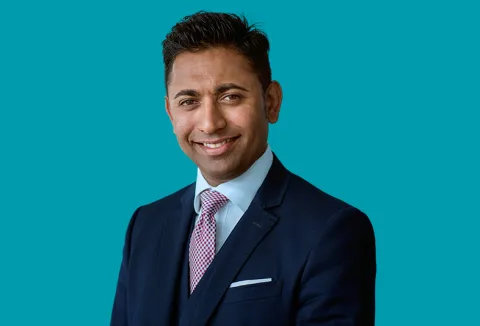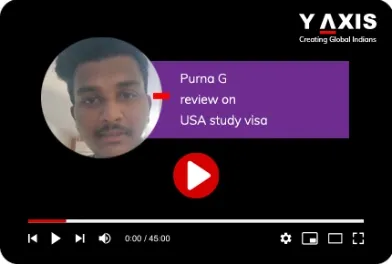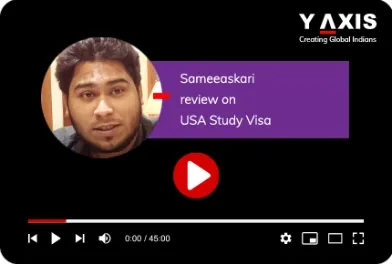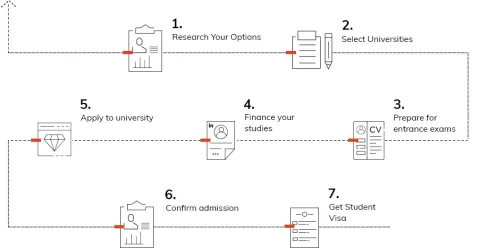The US universities are able to provide the best possible platform to international students with a student visa. This is evident from their high rankings making it worthwhile to study in USA. The country’s education system offers the most comprehensive coursework to students with an equal emphasis on both practical and theoretical learning.
- Affordable Education
- Diversity and Flexibility
- Outstanding support system for overseas students
- Healthy and Safe Communities
- Access to internships
- Exciting Campus Lifestyle
- Students must be over 18 years of age.
- International students can work on campus for up to 20 hours/week or less during the academic terms and full-time during the academic break periods, including the summertime.
- Off-campus employment requires some form of written or documented authorization issued by either the USCIS or OISS.
- To be eligible for any form of off-campus employment, you must be currently in legal status and have been enrolled as a student on an F-1 student visa in the US for a minimum of one academic year.
You will generally need the following for your US Student Visa application for US universities:
Approximate Tuition Fees in USD$
$15,000 to $40,000 per year
$20,000 to $40,000 per year
$20,000 to $45,000 per year
August/September
January/February
May/June
Student applicant:
In the United States, students have many work options to supplement their education and cover living expenses. On-campus employment is a popular choice, allowing students to work part-time within the university premises in roles such as library assistants or campus tour guides. Many students also explore off-campus employment through Optional Practical Training (OPT) or Curricular Practical Training (CPT), providing opportunities to gain practical experience in their field of study.
Additionally, internships, co-op programs, and research assistant positions are prevalent and offer valuable hands-on experience. The U.S. also permits certain students to work under the STEM OPT extension, fostering career growth in science, technology, engineering, and mathematics.
Spouse:
In general, spouses are given the same rights as students already in the U.S. Therefore, if the student with an F1 visa has the right to work, the spouse who comes to join him or her will also have that right.
Description
Massachusetts Institute of Technology (MIT)
Harvard University
Stanford University
University of California, Berkeley (UCB)
University of Chicago
University of Pennsylvania
Cornell University
California Institute of Technology (Caltech)
Yale University
Columbia University
Johns Hopkins University
University of California, Los Angeles (UCLA)
University of Michigan-Ann Arbor
New York University (NYU)
Northwestern University
Carnegie Mellon University
Duke University
University of Texas at Austin
University of California, San Diego (UCSD)
University of Washington
University of Illinois at Urbana-Champaign
Brown University
Pennsylvania State University
Boston University
Purdue University






Study in USA, USA Student visa, Study in USA, USA Student visa, US student visa requirements, How to apply for USA student visa, Post study work visa USA, Types of student visas in US, USA student visa processing time, international students in USA
Looking to study in the USA? Discover top universities, courses, fees, scholarships, and everything you need to make your study abroad journey a success!
Study in USA for Indian Students
With a world-class education and top-renowned universities, the United States of America is the world’s top study destination. The USA’s education system caters to comprehensive, skillful, and advanced learning. The USA is also ranked no. 1 for the education system that it provides.
About 1,075,496 international students study in the USA every year. The number of Indian students who study in the US has increased by 34%. Students who study in USA have a wide range of exposure and a great career scope, and there are many other benefits to learning in the USA.
The USA student visa is the F-1 student visa. This non-immigrant visa enables international students to enter the USA and study at universities and institutions certified by the Student and Exchange Visitor Program (SEVP). It is the most prominent US student visa for students wanting to study at a university or college in the United States.
A student can apply for an F-1 visa after an accredited and recognized university in the US has accepted the application.
Highlights
With more than 1M international students, the United States is the world’s most commonly chosen destination for studying abroad.
Here are the top reasons and benefits of studying in the US:
- High quality education system: The primary reason people choose to study in the USA is because of its unique education system. The USA has over 5,300 colleges and universities, and is home to some of the most prestigious educational institutions highly ranked in the QS world rankings 2024.
- Diversity and culture: The United States is also called the nation of immigrants, as people of different cultures, values, and beliefs come to the US and stay together. Indian students also benefit from this multicultural perspective o and adapt to cultural variations by studying in the US.
- Global recognition: The degrees in the US are widely recognized and accepted across the world. Most of the countries, especially the European countries, place great emphasis on the high standards of education provided by American institutions and acknowledge the rigorous academic curriculum and research-driven approach of American universities.
US education system
The education system in the USA is unique because it has various programs that attract international students from all around the world to the USA. The US education system is one of the most diverse for international students in the USA. It includes a problem-solving approach in its learning methodology.
The following are the types of categorizations of the US syllabus.
Types of Qualifications Available in the US
Along with traditional undergraduate, graduate, and postgraduate study, American universities offer many combined programs through which students can ultimately earn several degrees and diplomas. Combined programs are perhaps one of the most significant differences between American higher education and the educational systems of other countries.
Here is a list of degrees provided by the USA's education system:
|
Qualification |
Duration |
Description |
|
Associate Degree |
2 years |
Job oriented programs so a graduate can kick start a career |
|
Bachelor’s degree |
3 – 4 years |
Undergraduate degree including core courses, major, minor and elective. |
|
Master’s degree (Professional) |
1 -3 years |
Transition from first degree to a particular profession |
|
Master’s degree (Academic) |
2 years |
Degrees in traditional disciplines of humanities, arts, and science |
|
Doctorate or PhD |
5 – 8 years |
Done under supervision of an advisor. |
Public vs. Private universities in the US
Public universities: Public universities in the US is Also known as state universities. These universities are funded by the public through the government. These universities are financed by the state, which means the state provides funds to these universities to help develop the infrastructure of universities, provide better quality education opportunities
The private universities: The government does not finance or operate the private universities in the US. These universities receive funding from donors and private helpers. The private universities in the US are the most famous universities which include IVY league universities.
|
Public university in the US |
Private university in the US |
|
Funded by the state |
Funding primarily by endowment funds |
|
Low tuition costs as the government subsidized public universities |
Tuition costs are generally higher |
|
Wider range of classes and degrees programs |
Offer limited range of academic major |
|
Have more extensive academic programs |
Have academic programs focusing on learning outside the curriculum |
|
Larger than private universities |
Usually smaller than private universities |
|
Attract people from the surrounding area |
More diverse demographic |
|
University of California, Los Angeles University of Michigan University of Washington |
Harvard University Princeton university Stanford University |
Top Universities in the USA
Studying at one of the top-ranked universities in the USA will guarantee graduates a highly respected, recognized, and accredited degree. Degrees obtained from top universities in the US can open doors to many global employment opportunities.
Additionally, the top-ranking universities in the US offer international students the needed extensive support, career counseling, internships, part-time work, as well as post-study work opportunities, allowing them to gain practical exposure and increase their employment prospects.
The vibrant campus life and range of extracurricular activities in the USA contribute to the well-rounded academic experiences of students. Here is a list of top-ranked universities to study in the USA and their international fee.
|
Rank |
Name of the University |
Annual fee |
Acceptance Rate |
Notable Alumni |
|
1 |
$53,450 |
4% |
Kofi Annan, Buzz Aldrin, Richard Feynman, Sal Khan |
|
|
6 |
$51,143 |
3.2% |
Mark Zuckerberg, Rashida Jones, Natalie Portman and Matt Damon |
|
|
10 |
Stanford University |
$92,892 |
3.7% |
Larry Page, Reese Witherspoon, Tiger Woods, Reed Hastings |
|
11 |
California Institute of Technology (Caltech) |
$60,816 |
2.7% |
Kip Thorne, Linus Pauling, Gordon Moore, Howard Hughes |
|
12 |
University of Pennsylvania |
$88,960 |
6.5% |
Elon Musk, John Legend, Warren Buffet, Noam Chumsky |
|
12 |
University of California, Berkeley (UCB) |
$51,032 |
11.3% |
John Cho, Alex Morgan, Brenda Song, and Chris Pine |
|
16 |
Cornell University |
$65,000 |
7.8% |
Ratan tata, Shantanu Naidu, Bill Nye, Jane Lynch |
|
21 |
University of Chicago |
$108,000 |
5% |
Anna Chlumsky, Roger Erbert, Milton Friedman |
|
22 |
Princeton University |
$62,400 |
5.7% |
Jeff Bezos, Michelle Obama, Brooke Shields, Woodrow Wilson |
|
23 |
Yale University |
$67,250 |
4.6% |
Meryl Streep, Hilary Clinton, George Bush |
Popular Courses For International Students
Studying at one of the top-ranked universities in the USA will guarantee graduates a highly respected, recognized, and accredited degree.
Degrees obtained from top universities in the US can open doors to many global employment opportunities. Additionally, the top-ranking universities in the US offer international students the needed extensive support, career counseling, internships, part-time work, and post-study work opportunities, allowing them to gain practical exposure and increase their employment prospects.
The vibrant campus life and range of extracurricular activities in the USA contribute to the well-rounded academic experiences of students. Here is a list of top-ranked universities to study in the USA and their international fee.
|
Name of the course |
Top Universities |
Avg. Annual fee |
Popular fields |
|
Business Management |
Stanford Graduate school of Business, Penn Wharton, MIT, Harvard Business school, Columbia business school |
$80,374 |
Human Resource, Banking and Insurance, Finance, Marketing and sales, Digital Marketing |
|
Engineering |
MIT, Stanford University, University of California, Harvard University |
$58,009 |
Aerospace Engineering, Chemical Engineering, Civil engineering and Engineering Management |
|
Mathematics and Computer sciences |
MIT, Stanford University, University of California, Harvard University ,Columbia business school and Princeton University |
$82,730 |
Computer Engineering, Cyber security, Database administration, Information Technology, Software engineering |
|
Communication and Media studies |
Northwestern University, University of Pennsylvania, Johns Hopkins University and Cornell University |
$54,700 |
Contemporary visual narratives, Ethics and Journalism, Information governance |
|
Medicine |
Harvard University, Stanford University, John Hopkins University, Duke University and Columbia University |
$62,850 |
Pharmacology, Nutrition, Optometry, Nutrition, Pathology |
|
Physics |
Stanford University, Columbia University, NYU, University of California and George Institute of technology, |
$58,440 |
Quantum, Plasma and Fluids, Special and general relativity and Mathematical techniques |
|
Data science and Business Analytics |
MIT, Stanford University, University of California Berkeley, University of Pennsylvania, Carnegie Mellon University |
$86,300 |
Data architect, Financial analyst, Data engineer, Healthcare |
|
Social Science |
MIT, Stanford University, University of California Berkeley, Harvard University, Princeton University |
$86,300 |
Economics, Political science, anthropology, Sociology, History and Psychology |
|
Finance |
MIT, Columbia University, University of California Berkeley, University of California |
$87,600 |
Financial Planner, Risk management, Budget analyst, Investment Banking and Portfolio Management |
|
Physical and Life sciences |
Harvard University, Johns Hopkins University, Stanford University, University of California, Yale University |
$59,950 |
Microbiologist, Genetic counselor, Pharmacologist, Laboratory Technician |
US Student Visa For Indian Students
US student visa is required for international students to study in USA. Getting a USA student visa is a very important step to study in the US.
There are different types of USA student visas based on the purpose of study of the international student, each with its own eligibility and requirements. Here is the categorisation of the type of USA student visas.
Types of US Student Visas
|
Type |
Description |
Subtype |
|
F |
for international students pursuing an academic degree at an accredited US university. F-1 visa holders can work on-campus for 20 hours per week or less. To work longer, students must seek authorization from the US Citizenship and Immigration Services (USCIS). |
F-1: For full-time students. F-2: For dependents of F-1 visa holders (spouse and unmarried children under 21, including same-sex couples). F-3: For "border commuters" – Mexican and Canadian students who live in their country of origin while attending school in the US. |
|
M |
for students pursuing non-academic or vocational studies in the US. M-1 visa holders are admitted for a fixed period and may not stay longer than a year, except in medical cases. M-1 students cannot work on or off-campus. |
M-1: For students undertaking vocational or non-academic studies. M-2: For dependents of M-1 visa holders. M-3: For "border commuters" – Mexican and Canadian students attending vocational or non-academic programs. |
|
J |
for international students or visitors participating in exchange programs. J-1 visa holders typically stay in the US for one or two semesters and must return to their home country for at least two years after completing the program. |
J-1: For exchange students participating in specific cultural or academic programs. J-2: For dependents of J-1 visa holders. |
Documents Required for a USA Student Visa
To apply for a USA student visa, you need to prepare the following documents:
-
Original academic transcripts and certificates from all previous degree programs
-
Standardized test scores such as GRE, GMAT, TOEFL, IELTS, iTEP, or PTE Academic
-
Statement of Purpose (SOP) outlining your academic and career goals
-
Research proposal or essay, if required by your program
-
Letters of Recommendation from professors or employers
-
Valid passport with at least six months of validity beyond your intended stay
-
Proof of finances, including bank statements for the last 3 years
-
Printed DS-160 confirmation (online visa application form)
-
SEVIS fee receipt
-
Visa interview appointment letter (original and copy)
-
Form I-20 issued by your US university
-
Visa fee payment confirmation
-
Original mark sheets or provisional certificates
Having these documents ready and organized can help ensure a smooth visa application process.
Steps to Apply for a USA Student Visa (F1 Visa)
- Step 1: Begin the visa process as soon as you receive Form I-20 from your college and pay the SEVIS fee.
- Step 2: After paying the SEVIS fee, complete the DS-160 online visa application form.
- Step 3: Bring the DS-160 form to your visa interview.
- Step 4: Schedule and attend the biometric appointment and visa interview.
- Step 5: Wait for your visa approval.
USA Student Visa Processing Time
The processing time for a USA student visa is typically short, ranging from 1 week to a few months, depending on the type and complexity of the application. Generally, the visa application process takes a few days, and passport delivery may take 2-3 days. It is advised to apply at least three months before your intended departure to ensure timely processing.
Cost of USA student visa
No rules and regulations require a minimum bank balance to apply for a US student visa. The US F-1 student visa costs approximately USD 535. The cost is broken down into two further types of fees: the I-901 SEVIS fee ($350) and the DS-160 form fee ($185). Here is a breakdown of costs according to the type of visa.
|
Type of Fee |
F-1 visa type |
J-1 visa type |
M-1 visa type |
|
SELVIS |
$350 |
$220 |
$350 |
|
Visa application |
$160 |
$160 |
$160 |
Find Universities
Studying abroad in the USA is the land of endless opportunities and choices. Over 4,500 universities in the US offer undergraduate degrees. Harvard, Stanford, MIT, and Caltech are some of the top and most prestigious universities in the USA.
Every year, the number of international students who study in the US has only increased because students choose the US as the study destination to broaden their horizons and pursue education.
Here are some tips and factors to consider when choosing the best university.
- Choose a subject you’re passionate about; as a student, you will be spending 3-6 years studying it.
- Find universities in the US that align with your goals and offer strong faculty and resources.
- A degree from a top-ranked university (e.g., Harvard, Columbia) enhances career and employability prospects.
- Research if financial aid like scholarships, grants, and loans are available to help with tuition and living costs.
- Tuition ranges from $10,000 to $80,000 per year. Public universities offer more affordable options ($10,000–$22,000).
Admission Requirements to Study in the US Universities
Every university in the USA has its own admissions requirements for studying. There are specific standard requirements for almost every university and institution.
Generally, the following are the entry admission requirements for studying in the US, depending on the level of study and the documents required for a student visa in the USA.
|
Level of study |
Entry level admission requirements to study in US universities |
|
Bachelor’s degree |
A high school diploma or equivalent Minimum GPA 2.5 – 3.6 (or equivalent) Minimum TOEFL 61 – 100 (or equivalent) |
|
Undergraduate Pathway programs |
A high school diploma or equivalent Minimum GPA 2.0 – 3.0 (or equivalent) Minimum TOEFL 55 – 79 (or equivalent) |
|
Master’s degree |
A high school diploma or equivalent Minimum GPA 2.5 – 3.5 (or equivalent) Minimum TOEFL 78 – 100 (or equivalent) |
|
graduate Pathway programs |
A high school diploma or equivalent Minimum GPA 2.5 – 3.4 (or equivalent) Minimum TOEFL 55 – 99 (or equivalent) |
Scholarships for International Students:
There are various scholarships available for international students studying in the USA, which are available in both partially funded and fully funded scholarships that include monthly stipends covering tuition fees, accommodation charges, health insurance, and travel allowance. The following are the types of scholarships for international students studying in the USA.
Government-funded US scholarships for International students
|
Name of the Scholarship |
Eligibility |
Amount / Benefit |
|
Fulbright foreign student program |
Graduate students, young professionals and artists and also Open to international students in all fields excluding medicine. |
Covers full tuition fee, a living stipend, full accommodation fee, airfare and health insurance. |
|
Hubert Humphrey Fellowship program |
international, experienced professionals who want to undertake 10 months of academic study in USA |
Tuition fees waiver, Accident and Sickness Program, expenses for books and supplies, monthly maintenance allowance, Airfare covers round-trip charges. |
Non – Governmental US scholarships for International students
|
Name of the Scholarship |
Eligibility |
Amount / Benefit |
|
Civil society leadership awards |
Master’s degree study to individuals who clearly demonstrate academic and professional excellence and a deep commitment to leading positive social change in their communities. |
Tuition and fees, Monthly stipend of USD 12,967, Program-related travel, Health insurance, All costs for an annual student conference, A pre-university writing program |
|
Surf shark Privacy and Security Scholarship |
Student currently enrolled in the US or another study destination as a high school, undergraduate or graduate student. |
A $2,000 prize |
|
Tortuga Backpacks Study Abroad Scholarship |
Passionate international students wishing to study in USA |
$1,000. |
|
Preply Scholarship |
Open to all students aged between 16 and 35. To enter, you'll need to submit a 500-word essay related to online education, multilingualism, and professional development. |
$2,000. |
Tuition Fee and Other Expenses for Students
It is a well-known fact that the USA is the most popular and the most common choice for international students because of the country's excellent reputation in education and the presence of such prestigious and highly acclaimed universities. However, it is essential to account for factors like college fees when studying in the USA as an international student.
Tuition fees account for a major component determining the overall cost of studying in the USA. The public or the state-owned universities are generally more affordable and cheaper than private institutions. International students who are studying in the US can expect annual costs or expenses ranging from $25,000 - $45,000 to cover tuition and living costs.
The private non-profit colleges are slightly more expensive, and additionally, the cost of living will be around US$60,000 per year. The public US universities run by the state are a more affordable option with lower tuition fees. Here is a complete list of types of colleges and their annual fees.
|
College type in USA |
Average Tuition fee |
Housing and food |
|
Public two year colleges (in district) |
$3,990 |
$9,970 |
|
Public four year colleges (in state) |
$11,260 |
$12,770 |
|
Public four year colleges (out of state) |
$29,150 |
$12,770 |
|
Private nonprofit four year colleges |
$41,540 |
$14,650 |
Top Courses And Fees
|
Name of the programme |
Average Tuition fee |
|
Undergraduate (UG) |
$8000 - $4000 |
|
Associate |
$3800 |
|
Postgraduate (PG) |
$10,000 - $60,000 |
|
Doctoral |
$28,000 - $55,000 |
|
English language studies |
$700 - $2000 (monthly) |
|
Engineering |
$30,000 - $75,000 |
|
MBA |
$50,000 - $60,000 |
|
Diploma |
$5000- $20,000 |
Cost of Studying at Top Universities in the US:
|
Rank |
Name of the University |
Annual International fee |
|
1 |
Massachusetts Institute of Technology (MIT) |
$53,450 |
|
6 |
Harvard University |
$51,143 |
|
10 |
Stanford University |
$92,892 |
|
11 |
California Institute of Technology (Caltech) |
$60,816 |
|
12 |
University of Pennsylvanian |
$88,960 |
|
12 |
University of California, Berkeley (UCB) |
$51,032 |
|
16 |
Cornell University |
$65,000 |
|
21 |
University of Chicago |
$108,000 |
|
22 |
Princeton University |
$62,400 |
|
23 |
Yale University |
$67,250 |
Course Wise Cost of Studying in the US
Tuition fees are one of the crucial aspects and the primary expenses of studying in the USA. On average, the annual cost of studying in the USA for international students is INR 38,00,000.
The fees to study in the USA vary depending on the course undertaken, type of degree program, university basis, etc. Here is a breakdown of the cost of studying in the USA based on degree choice:
|
Name of the course |
Avg. Annual fee |
|
Business Management |
$80,374 |
|
Engineering |
$58,009 |
|
Mathematics and Computer sciences |
$82,730 |
|
Communication and Media studies |
$54,700 |
|
Medicine |
$62,850 |
|
Physics |
$58,440 |
|
Data science and Business Analytics |
$86,300 |
|
Social Science |
$86,300 |
|
Finance |
$87,600 |
|
Physical and Life sciences |
$59,950 |
Cost of Living in the USA
Budgeting the cost of living required to live in the USA is important for international students, professionals, families, or anyone who is moving to the USA. The average cost of living in the USA is approximately $2,500 and $3,500 per month.
This cost of living includes food, housing, transportation, health care, taxes, and other expenses. Though the cost of living in the USA is quite expensive, it varies across the states and cities.
San Francisco, New York, Boston, and Los Angeles are some of the most expensive cities in the USA. Cities like Cincinnati or Oklahoma City have much lower and more affordable costs. Mississippi is the cheapest state in the United States. Here is a breakdown of the living expenses in the USA.
|
Living expenses |
Average Annual cost |
|
Apartment housing including utilities |
$17,200 - $21,710 |
|
Food |
$6,500 |
|
Dormitory Housing |
$7,588 - $11,914 |
|
Transportation |
$2,180 |
|
Books and study material |
$500 - $1000 |
|
Travelling |
$500 - $1200 |
|
Clothes and footwear |
$500 |
|
Miscellaneous Expenses |
$6,700 |
Post Study Work Visa USA
Every international student studying in the USA wishes for a Post-Study Work visa. The post-study work visa is one of the most crucial factors for students pursuing higher education in the USA.
As an F1 student visa holder, international students can complete up to a year of temporary employment directly related to their major field of study. After completing their studies, F1 visa holders can also apply for off-campus work opportunities called Optional Practical Training (OPT), which enables international students to stay and work for three years in the USA.
International students in the USA must look for jobs in the field of study, and the period they are given to look for employment is 90 days. Students can apply for an extension of the STEM OPT 90-day expiration of the current 1-year OPT.
Types of OPT
- Pre-Completion OPT: It allows international students in USA to work while studying.
- Post-Completion OPT: It allows international students in the USA to work after completing their degree courses.
Eligibility requirements for Optional Practical Training in the USA:
- The field of employment must be directly related to the major pursued.
- The candidate must maintain lawful F-1 status.
- They must apply for OPT before completing all work required for the degree.
- The candidate can work before or after completing your degree, or both.
- In the US, for up to 12 months after completing your coursework.
- OPT work must be part-time, at least 20 hours a week, or full-time, at 40 hours a week.
- All OPTs should be completed within 14 months after a higher education degree is completed.
How To Apply for an OPT Extension
- Submit Form I-765 up to 90 days before the current OPT employment authorization expires.
- Pay the application fees for the I-765 form.
- Mention the name of the employer as listed in E-Verify.
- Provide the required documents like the E-Verify Company Identification Number of the employer, Copy of the student’s STEM degree, Form I-20, and Certificate of Eligibility for Nonimmigrant Student Status, approved by your designated school official (DSO) within the last 60 days.
- Wait for the OPT extension decision.
List of Few STEM-Related Degrees Valid for an OPT Extension
- Actuarial sciences
- Computer science applications
- Engineering
- Engineering Technologies
- Life sciences
- Mathematics
- Military technologies
- Physical sciences
Post-Study Work Opportunities in the US with an H-1B Visa
The H-1 B visa, also called the Person in specialty occupation visa, is an immigrant visa that enables international students in the USA to work for American companies. Candidates who apply for jobs in the US must receive a job offer from a US-based company and work in the skills and specialized knowledge-demanding field. This visa is valid for 3 years and can be extended for 6 years, depending on the nature of the work.
The eligibility requirements for the H-1 B visa are as follows:
- Possession of an advanced education of a four-year BA degree or MA or PhD degree.
- There must be a correspondence between the candidate’s degree, work experience, and job duties.
- Approval of a labor condition attestation (LCA) from the Department of Labor prior to filing the H-1B petition with Immigration and Naturalization Services.
How To Apply for H1-B Visa
- The candidate must check for their eligibility to apply for an H1-B visa.
- Apply for a job opening that is active in the US.
- Request the employer for initiation of an H1-B VISA petition.
- Apply for the H1-B visa at the closest US embassy.
Related Articles:
- Best Universities in the USA for MS
- Engineering Colleges in the USA for Indian Students
- Colleges for Bachelor's Degree in the USA
- University of California Berkeley Master's Programs
- Berkeley Master's Programs
- Boston University Acceptance Rate
- Universities in New York for Masters
- University of California San Diego Master's Programs
- MS in the USA
Ready to study in the USA? Contact Y-axis Study Abroad Consultants today for expert guidance on admissions, visas, scholarships, and more. Start your journey now!

